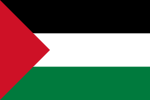The Arab Baʽath Movement (Arabic: حركة البعث العربي Ḥarakat al-Baʽth al-‘Arabī), also literally translated as Arab Resurrection Movement or Arab Renaissance Movement, was the Baathist political movement and predecessor of the Arab Socialist Baʽath Party.[1] The party was first named Arab Ihya Movement (Ḥarakat al-Iḥyāʼ al-‘Arabī) literally translated as Arab Revitalization Movement, until 1943 when it adopted the name "Baʽath".[2][3] It was founded in 1940 by Michel Aflaq.[4][5][6] Its founders, Aflaq and Bitar, were both associated with nationalism and socialism.[7]
Arab Ba'ath Movement حركة البعث العربي | |
|---|---|
 | |
| Leader | Michel Aflaq and Salah al-Din al-Bitar |
| Founded | 1940 |
| Dissolved | 1947 |
| Preceded by | Party of National Brotherhood |
| Succeeded by | Ba'ath Party |
| Newspaper | Al-Tali'a |
| Ideology | Ba'athism |
| Colors | Black, Red, White and Green (Pan-Arab colors) |
History
editThe Movement was formed in 1940 as the Arab Ihya Movement by Syrian expatriate Michel Aflaq.
Shortly after being founded, the Movement became involved in anti-colonial Arab nationalist militant activities, including Aflaq founding the Syrian Committee to Help Iraq that was created in 1941 to support the anti-British and pro-Axis government of Iraq against the British during the Anglo-Iraqi War of 1941.[8] The Syrian Committee sent weapons and volunteers to fight alongside Iraqi forces against the British.[9]
Aflaq unsuccessfully ran as a candidate for the Syrian parliament in 1943.[10] After the Syrian election defeat, the Movement sought cooperation with other parties in elections in Syria, including the Arab Socialist Movement of Akram El-Hourani.[11]
The Party merged with Al-Arsuzi's Arab Baʽath Party in 1947, and al-Hawrani's Arab Socialist Movement later merged into the party in the 1950s to establish the Arab Socialist Baʽath Party.
References
edit- ^ Jasim M. Abdulghani. Iraq & Iran: the years of crisis. Croom Helm, Ltd., 1984. Pp. 27.
- ^ Michel Curtis. People and Politics in the Middle East. Transaction Books. Pp. 132, 139.
- ^ Jasim M. Abdulghani. Iraq & Iran: the years of crisis. Croom Helm, Ltd., 1984. Pp. 27.
- ^ Michel Curtis. People and Politics in the Middle East. Pp. 132.
- ^ David Seddon. A political and economic dictionary of the Middle East. London, England, UK: Taylor & Francis e-library, 2005. Pp. 19.
- ^ Ghareeb, Edmund A.; Dougherty, Beth K. Historical Dictionary of Iraq. Lanham, Maryland and Oxford: The Scarecrow Press, Ltd., 2004. Pp. 2.
- ^ Rami Ginat. Egypt's incomplete revolution: Lutfi al-Khuli and Nasser's socialism in the 1960s. Routledge, 1997. Pp. 11.
- ^ Spencer Tucker. The Encyclopedia of Middle East Wars: The United States in the Persian Gulf, Afghanistan, and Iraq Conflicts, Volume 1. Santa Barbara, California, USA: ABC-CLIO, 2010. Pp. 30
- ^ Spencer Tucker. The Encyclopedia of Middle East Wars: The United States in the Persian Gulf, Afghanistan, and Iraq Conflicts, Volume 1. Santa Barbara, California, USA: ABC-CLIO, 2010. Pp. 30
- ^ Spencer Tucker. The Encyclopedia of Middle East Wars: The United States in the Persian Gulf, Afghanistan, and Iraq Conflicts, Volume 1. Santa Barbara, California, USA: ABC-CLIO, 2010. Pp. 30
- ^ Spencer Tucker. The Encyclopedia of Middle East Wars: The United States in the Persian Gulf, Afghanistan, and Iraq Conflicts, Volume 1. Santa Barbara, California, USA: ABC-CLIO, 2010. Pp. 30